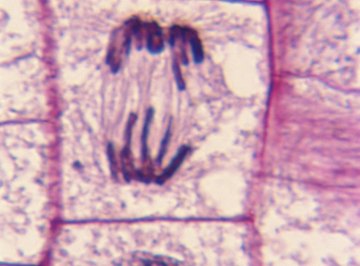
DNA, the substance responsible for expressing the genetic makeup of all living organisms, is a long narrow molecule composed of a sugar-phosphate backbone that supports a precise sequence of smaller molecules called nucleotide bases. Cells read sections of DNA called genes to control the production of proteins that establish the cell’s characteristics.
Chromatin and chromosomes are different forms of the same material that work by packaging DNA molecules to fit and operate in tiny cells. Packaging isn't the only chromosome and chromatin function, though. It can also function to help regulate gene expression.
Packaging Challenge
Eukaryotic organisms, which include all but the simplest forms of life, have cells that contain a central walled-off region called the nucleus. Most of a cell’s DNA resides in the nucleus, which creates quite a packaging challenge. If you stretched out all the DNA in a human cell, it would extend about 3 meters.
Nature has found a way to stuff all that DNA into a nucleus that is only 1/100,000 of a meter in diameter. Not only must the cell tightly compress the nuclear DNA, it must also sensibly arrange the DNA so that a cell can access the portions it wants to use.
Chromatin Definition
We define chromatin by its makeup and function. Chromatin is a combination of DNA, ribonucleic acids, and proteins called histones that fill the cell nucleus. The histones attach to and compress the double-helical strands of DNA. The chromatin forms bead-like structures called nucleosomes, compacting the DNA by a factor of six.
The string of beads then coils into a hollow tube shape, the solenoid, which is 40 times more compact. Chromatin can achieve high compression in part by neutralizing the negative electric charges that predominate throughout the DNA molecule and that would otherwise resist compression. One type of chromatin, called euchromatin, actively regulates gene activity, while heterochromatin keeps inactive regions of the DNA molecule tightly bound.
When the DNA is tightly bound, the genes in that region aren't able to be transcribed since the transcription machinery (enzymes and other molecules) cannot physically get to the gene. When chromatin is loosely bound, on the other hand, genes can be more easily transcribed and expressed.
Chromosomes
Chromosomes form when a cell is about to divide, at which time the spaghetti-like chromatin compresses even further, by a factor of 10,000. The resulting condensed body is a chromosome, which usually resembles a large X. The four arms of the X join at the central portion called the centromere. Most human cells have 46 chromosomes in two sets of 23, each set donated by a parent.
The chromosomes duplicate themselves and distribute evenly to each daughter cell during cell division. After cell division is finished, the chromosomes enter a period called interphase and ease back into chromatin strands.
Prokaryotes have something similar to chromosomes and chromatin, but it isn't quite the same. Instead of the same complexes that are in eukaryotes, prokaryotes simply "supercoil" their DNA in order to fit it inside the cell. Prokaryotes also only have one "clump" of DNA called the nucleoid. While there are proteins associated with this supercoiling, it isn't the same structure or set-up as chromatin.
Chromatin Function: Condense and Relax
Transcription occurs only during interphase. During transcription, the cell copies specific DNA genes onto RNA, which it subsequently translates into proteins. During interphase, the chromatin is relatively relaxed, allowing the cell’s transcription machinery to access DNA genes.
Euchromatin surrounds genes eligible for transcription and plays an active role in the process. Heterochomatin attaches to inactive portions of the DNA molecule. Chromatin condenses into chromosomes and then relaxes again as the cell alternates between division and interphase.
References
About the Author
Based in Greenville SC, Eric Bank has been writing business-related articles since 1985. He holds an M.B.A. from New York University and an M.S. in finance from DePaul University. You can see samples of his work at ericbank.com.
Photo Credits
Jupiterimages/Photos.com/Getty Images
